Description
As used here, ‘infrastructural engagements’ are rather more territorial than they are about housing and building types
[1]
Infrastructural Engagements: Unit, type and use mixes
Relatively early on in Japan’s and Tokyo’s process of modernization direct engagement between railroad infrastructure and housing was a significant component of urban expansion. The circumferential Yamanote line that roughly circumscribed the 23 inner-city wards of Tokyo was completed by Japan Rail – the national rail company – by 1919. Urban expansion beyond was accelerated in the wake of the disastrous Kantō earthquake of 1923 and often took the unusual form of real estate companies and promoters going into the railroad business in order to make their suburban sites more accessible and, therefore, more attractive. This applied to both residential as well as to retail commercial markets still visible today with the naming of subway lines according to retail chains like Tōkyū. Amid these developments, Shibusawa Eiichi founded his Garden City Corporation in 1918 with the aim of demonstrating the efficacy of Garden City principles in the urbanization of Tokyo.
[2]
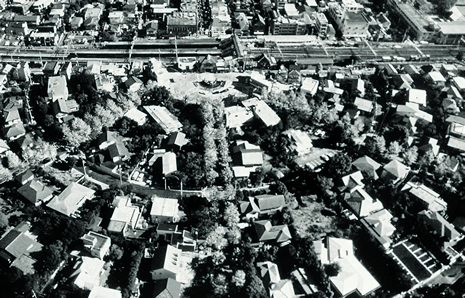
Denenchōfu, Tokyo
Garden City Corporation, 1924
Housing responding in the opposite direction, namely to the opportunities presented by infrastructure investments, like railroads, are far more common and generally follow, in the density and type of configuration, relationships corresponding roughly to ‘highest and best use’ of land based on accessibility. One such project is housing associated with Euralille, France,
[3]
Manifestation of the literal presence of an infrastructural element in conjunction with housing occurred with the so-called ‘wall’ component of the Byker Redevelopment in Newcastle-upon-Tyne of 1969 through 1982, mentioned earlier. As described, the issue at hand was audial and visual screening of a motorway that was planned to pass along the northern edge of the project. It also provided spatial enclosure to the Byker community and evoked a certain recall of a Roman wall that allegedly had been built in the general area during antiquity. As it turned out, the motorway was never built, but its anticipation in the Kendall neighborhood of the community led to the architectural reification of the line of the roadway improvement.
[4]
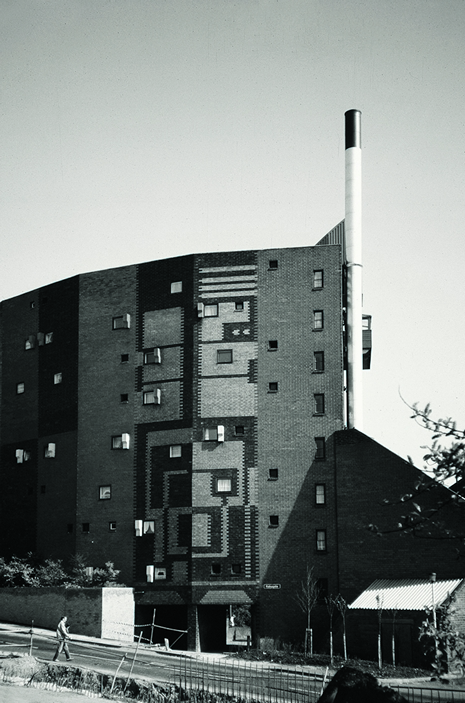
Byker Redevelopment, Newcastle-upon-Tyne
Ralph Erskine, 1969-82
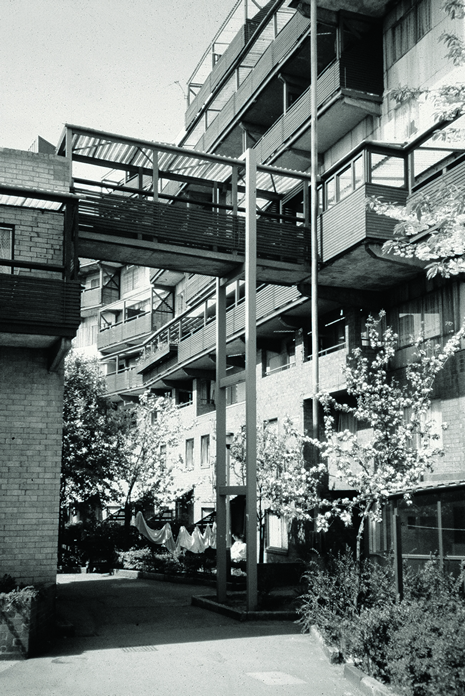
Byker Redevelopment, Newcastle-upon-Tyne
Ralph Erskine, 1969-82
Another example of the overt manifestation of infrastructures occurred at the Malagueira Quarter housing project by Álvaro Siza, dating from 1977, in Évora in central Portugal. Built on the site of the Quinta da Malagueira, a former
[5]
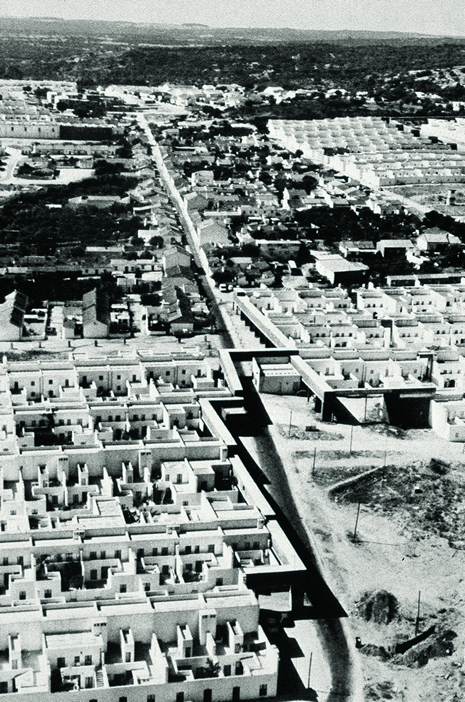
Malagueira Quarter, Évora, PortugalÁlvaro Siza, 1977
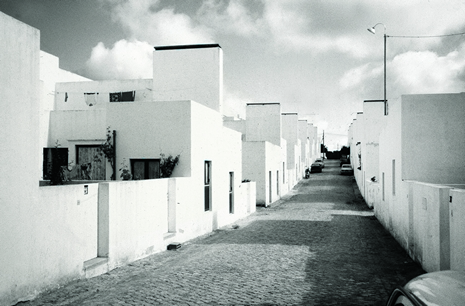
Malagueira Quarter, Évora, PortugalÁlvaro Siza, 1977
With regard to infrastructural engagements, concerned with occupation of sites of former infrastructural improvements, there are, of course, many precedents in various parts of the world. These could include the Charlestown Navy Yard housing in Boston, Massachusetts, parts of the Docklands in East London, and even Battery Park City in New York. In addition to replacing the finger wharves that extended into the Hudson River on Lower Manhattan’s west side, the last project also involved landfill to fully create the site, taken largely from the excavations of the World Trade Center Towers built in 1973. The plan that was implemented was by Cooper & Eckstut in 1979 and extended the roadway infrastructure of the city into the landfilled site, culminating in a well-amenitized pedestrian promenade along the riverfront of the project.
[6]
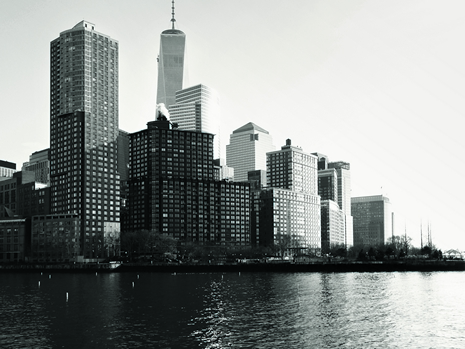
Battery Park City, New York
Cooper & Eckstut, 1979
The docklands of Amsterdam also offered an opportunity for the city to reclaim the prime waterfront site, for the importance of the local shipping industry had been declining for years. Besides the Borneo Sporenburg project, which was briefly discussed as part of the Eastern Harbor District redevelopment in the previous chapter, an earlier example that later became influential was the IJ-Plein by OMA, designed between 1980 and 1982, and completed in 1988. Located across the Het IJ from Amsterdam’s historic center and the Eastern Harbor District (Oostelijk Havengebied), the site was a former shipyard right at the tip of the industrial district known as Amsterdam-Noord. Prior to the 1900s, Amsterdam-Noord was not considered an official part of Amsterdam city; its administrative recognition and emergence at the turn of the twentieth century was associated with the concentration of industries, particularly those related to shipping, resulting in its growth as a working-class, industrial area. The area’s fortunes changed, however, after the Second World War and during the latter half of the twentieth century with the beginnings of de-industrialization and the city’s diminishing role as a major shipping port.
With the closure of the west harbor division of the Amsterdam Dry Dock Company that had occupied the site right at the tip of Amsterdam-Noord bordering the IJ, a window of opportunity presented itself for the construction of the IJ-Plein, the first housing project in the district to recover the waterfront, a significant change of orientation for a city that had essentially turned its back to the harbor for most of the nineteenth and twentieth centuries. In fact, as early as 1974, the city had revealed its plans to convert the shipyard and the IJ-Plein and its environs into a new residential sub-centre for the city, under the direction of the Stuurgroep Aanvullende Woningbouw or Steering Group for Supplementary Housing which played a central role in urban renewal.
[7]
[8]
[9]
The neighboring residents, however, vetoed the high-rise element of OMA’s initial proposal, prompting the team to revise the western section based on the model by the Luckhardt brothers in Berlin during the 1920s for a ‘
[10]
[11]
Of the pair of parallel blocks by OMA, the longer slab with a built area of 11,860 square meters is raised on
Separated by a pedestrian court is the shorter of the two blocks, with a built area of 4,560 square meters. Here, unlike the switch-back stairs that are spaced regularly along the longer block, the façade of this shorter block is lined with a multitude of glass-covered stoops providing direct access to three- or four-bedroom apartments on the first three floors, creating a rhythmic interplay and contrast between the two bars. Inside the seemingly straightforward block, OMA introduced a system of lateral cascading stairs running through the spine of the block, resulting in an ingenious stacking of apartment units, and communal living arrangements on the top floor. In total, 202 units ranging from dormitories to five-room configurations are accommodated in this pair of buildings. Within the dwelling units, which are no more than 15 meters deep in the longer block and 11 meters deep in the shorter one, glass walls are copiously deployed, such as between the living and dining areas, lending a sense of spaciousness as well as transparency. In addition to the lengths of these buildings that reify the original dimensions of the shipyard site, the intentional choice of materials, in particular the metal-clad staircases and elevator shaft, and the perforated steel columns, pay homage to the industrial heritage of the place, albeit in modern, subtle gestures.
If the IJ-Plein had set the precedence for subsequent redevelopment of the abandoned docklands in Amsterdam, the Eastern Harbor District, of which Borneo Sporenburg was a part, arguably showcases the evolution and array of spatial strategies in revitalizing former infrastructural sites in a key area of the urban center. Identified as early as 1974 to be a sub-centre, the Eastern Harbor District took another 13 years of much planning and revision before the first pylons were driven into the ground for the new residences that would later occupy the site. Up until the mid-1980s, land reclamation and filling-in of the docklands was the
[12]
[13]
To overcome the problem of north-south connection across the site, and together with a policy on improving the competitiveness of public transport beginning in the 1980s, bus routes were introduced as the islands were transformed in phases, running in a radial fashion primarily along the western edges of the islands and the length of Java-eiland, with occasional stops extending into the middle of the islands, as was the case of Sporenburg. The bus services were supplemented by the extension of tram lines to Java-eiland and the opening of the IJ-tram that traversed the district in an east-west manner terminating at the IJ-burg further out to the east. Development on Borneo Sporenburg was initiated in 1992, and at that time, a survey of the recently completed KNSM-eiland revealed that there were only singles or couples residing in the owner-occupied apartments with hardly any children.
[14]
[15]
After two rounds of commissioned studies by nine different architectural firms, the scheme by West 8 was selected for its incorporation of the basic design principles set out by the Spatial Planning Department. Refined later by Rudy Uytenhaak, who had devised the Java-eiland plan, the scheme was composed of low-rise, high-density housing bands that combined street-front and walk-up units, terminating in ‘end block’ typologies that responded to the idiosyncratic parcels at the ends, as well as the ‘meteorites’ inspired by the large blocks such as the Piraeus located across on the KNSM-eiland. By combining this sea of single-family dwellings with the apartment complexes, Adriaan Geuze and his team were able to attain the density stipulated by the city and the developer. Within this primarily residential order were other programs including two schools, a sports center, a medical institution, shops, offices, restaurants, and a yacht club. The most unusual and arguably most documented feature of this project built between 1996 and 2000 was the 60 freehold parcels that were sold to individual owners through a lottery system by the municipality in which the owners had the autonomy to work with their preferred architects in designing their canal houses.
To maintain the formal and figural cohesiveness of the two islands while still producing an impressive assortment of architectural expressiveness, the owners and architects had to work within the design parameters established by West 8 in their re-interpretation of the traditional Dutch canal house. First and foremost, a 30 to 50 percent void was dictated within each of the free parcels, resulting in creative internal configurations through the rhythmic interplay of voids and solids. In doing so, the typical outdoor gardens and spaces in the Dutch row house were interiorized, complete with private courtyards, roof gardens, and patios. A second specification was for individual access to each of the single-family dwellings, such that each unit had a front door to the street, as opposed to the shared access in the sculptural blocks or the mid-rise complexes on the other islands. A major deviation from the conventional floor-to-floor height of 2.4 meters in the Dutch context was a push towards a higher standard of 3.5 meters.
[16]
[17]
For the 60 free parcels in particular, these guidelines generated an architectonic diversity, both in the floor plans and the façades, within a uniform urban envelope. Apart from local Dutch architects who were commissioned to design these free parcels, internationally-renowned architects like Herzog & de Meuron, Xaveer de Geyter, and MVRDV were also involved. In Borneo 12 and Borneo 18, for instance, which were designed by MVRDV, two distinct elevations on the street front were deployed: Borneo 12 as a seemingly enclosed solid mass with a void in the form of a private alleyway occupying half the width as compared to the transparent glass-box-like façade of Borneo 18. Spatially, Borneo 12 played on the notion of ‘bands’ in the two islands, dividing the mass into two narrow ‘strips’. One of the strips runs through the entire depth of the parcel at the full height of 9.5 meters, while the other is broken down into two volumes grafted onto the main ‘stem’; the displacement of these two volumes allows the continuation of the void into the house, creating an air well that brings in more light into the house. The lower of the two volumes contains a double-height work space, while the other which extends across the upper two floors of the house serves as a bedroom/bathroom suite. In Borneo 18, MVRDV began with a four-storey section measuring 12 meters deep that was cleverly accommodated within the height confines of the envelope. Here, a void was left at the back of the house fronting the canal, creating a four by five meter garden plot on the basement level right by the water. However, by sliding the second floor out towards the back, this resulted in the capacious, light-filled living room extending three storeys in height on the front, and an outdoor balcony on the third floor resting atop the enclosed block, housing the bedroom and bathroom, with a view above the canal on the second floor.
[18]
The rest of the end blocks and low-rise dwellings were subjected to the same design provisions, and given over to a cast of international and local architects, including OMA, Josep Lluís Mateo, UNStudio, Kees Christiaanse, and Claus en Kaan. In Mateo’s rectilinear housing block at the head of the Borneo island, a total of 11 different floor plans ranging from 110 to 180 square meters were accommodated in the 26 narrow terraced houses arranged back to back. While the project comes across as a massive, tight scheme on the exterior, clad in red cedar timber paneling on the southern façades and brickwork on the northern facades, relief is provided by the cutouts on the upper two floors yielding small private courtyards, gardens, and roof terraces, as well as internalized green spaces.
[19]
[20]
Looking across this material, several general observations can be made. First, there is a relative independence, in this largely territorial type, of housing types
Then too, the presence of former or existing infrastructure can present both opportunities and constraints for housing and suggest contextual manners of shaping housing. The wharves at Borneo Sporenburg, for instance, suggested a historical landscape of attached row house-like dwellings, so typical of Amsterdam waterfronts, which was partially emulated in the contemporary proposal. The focal point of the station at the center of the Denenchōfu estate clearly suggested the radiating pattern of streets emanating from the small plaza in front of the station. Also, the Byker Wall had really no other alternative but to follow and parallel the alignment of the planned motorway. Further, in a closely related manner, the introduction of housing in place of infrastructure rather immediately offers a different reading and ambience to a section of a city. Suddenly it is habitable and approachable rather than being only serviceable and often off-limits. It is also a domestic landscape in lieu of one that is commercial or industrial. Finally, in those cases where some aspect of infrastructure is reified, such as the viaduct of utilities at Malagueira, a question arises as to whether the strong formal manifestation of infrastructure is justified. In other words, in what terms should this aspect of the project really be assessed? Of course, in this particular case, the reification of the infrastructure is largely symbolic, even if it is functional and offers a certain ease of longer-term maintenance. Moreover, it is symbolic in at least two senses. First, it connotes a kind of community solidarity among residents who are typically often footloose. Second, it is also in line with a long-standing chronicle of the manner in which water and other utility resources are brought to the landscape of Évora in Portugal, namely via viaducts and aqueducts.
Footnotes
Jeffrey E. Fulmer, “What in the World is Infrastructure?,” Infrastructure Investor (July–Aug 2009): 30–32, accessed October 20, 2013, http://www.corridortrust.com/uploads/Infrastructure_Investor.pdf
Ken Tadashi Oshima, “Denenchōfu: Building the Garden City in Japan,” Journal of the Society of Architectural Historians 55 (June 1996): 140–151, 218.
“Euralille, Lille, France”, GA Document 41 (November 1994); 36–65; “Xaveer de Geyter, 1992–2005”, El Croquis 126 (2005): 44-49.
Colin Emery, “Byker by Erskine: Housing, Byker, Newcastle upon Tyne,” Architectural Review 156 (December 1974): 346–362; and Peter Buchanan, “Landscaping at Byker, Newcastle upon Tyne,” Architectural Review 156 (December 1974): 334–343.
Pierluigi Nicoli, “Quinta da Malagueira, Évora,” in Álvaro Siza: Poetic Profession; Kenneth Frampton, Nuño Portas, Alexander Alves Costa, Pierluigi Nicolini (New York: Electa/Rizzoli, 1986), 10–23; Jean-Paul Rayon, “Il Quartiere Malagueira a Évora,” Casabella 478 (March 1982): 2–15; Peter G. Rowe, Byker Project, United Kingdom and Malagueira Quarter, Portugal (Cambridge, MA: Harvard Graduate School of Design, 1988); Brigitte Fleck, Günter Pfeifer (eds.), Malagueira. Álvaro Siza in Évora (Freiburg: Syntagma, 2013).
Eric Firley and Katharina Grön, The Urban Masterplanning Handbook (Chichester, UK: Wiley, 2013), 62–75.
Allard Jolles, Erik Klusman, and Ben Teunissen, Planning Amsterdam: Scenarios for Urban Development, 1928–2003 (Rotterdam: NAi Publishers, 2003).
Bernard Leupen, IJ-Plein, Amsterdam: Een Speurtocht Naar Nieuwe Compositorische Middelen: Rem Koolhaas, Office for Metropolitan Architecture (Rotterdam: Uitgeverij 010, 1989), 109.
Thomas Fisher, “Logic and Will,” Progressive Architecture 71 (March 1990): 98–99.
Leupen, IJ-Plein, Amsterdam, 110.
Leupen, IJ-Plein, Amsterdam, 111.
Jan de Waal, “Living in the Eastern Harbour District,” in Eastern Harbour District Amsterdam: Urbanism and Architecture, ed. Jaap Evert Abrahamse et al. (Rotterdam: NAi Publishers, 2006), 85.
Allard Jolles, “Tail Winds,” in Eastern Harbour District Amsterdam: Urbanism and Architecture, ed. Jaap Evert Abrahamse et al. (Rotterdam: NAi Publishers, 2006), 27.
Ton Schaap, “Collective Curiosity, the Development of Borneo/Sporenburg in Amsterdam, 1992–1995,” A+U 380 (May 2002): 56.
Marlies Buurman, “Borneo and Sporenburg.” in Eastern Harbour District Amsterdam: Urbanism and Architecture, ed. Jaap Evert Abrahamse et al (Rotterdam: NAi Publishers, 2006), 131.
Schaap, “Collective Curiosity, the Development of Borneo/Sporenburg in Amsterdam, 1992–1995,” 58.
Graham Smith, “Design coding in Amsterdam – Borneo and Sporenburg,” rudi.net, accessed November 2, 2013, http://www.rudi.net/books/15907
“Borneo 12,” MVRDV, accessed November 2, 2013, http://www.mvrdv.nl/projects/BORNEO.12/ ; “Borneo 18, MVRDV, accessed November 2, 2013, http://www.mvrdv.nl/projects/BORNEO.18/
Christian Schittich, High-Density Housing: Concepts, Planning, Construction (Munich: Edition Detail, 2004), 86–95.
Hans Ibelings, Claus en Kaan: Building (Rotterdam: NAi, 2001), 80–85.
Internal Links
Originally published in: Peter G. Rowe, Har Ye Kan, Urban Intensities: Contemporary Housing Types and Territories, Birkhäuser, 2014.